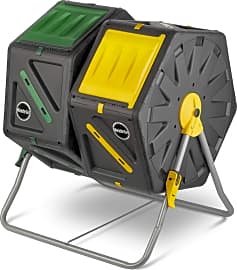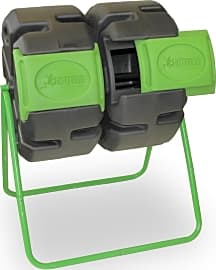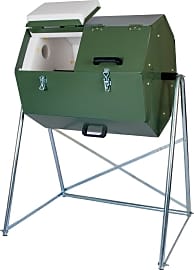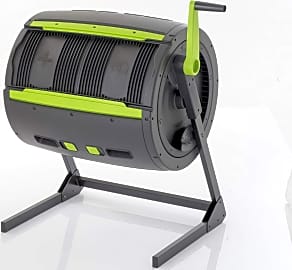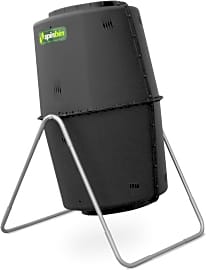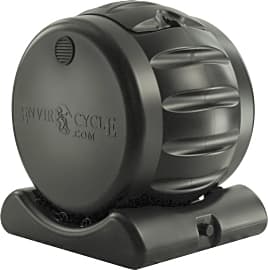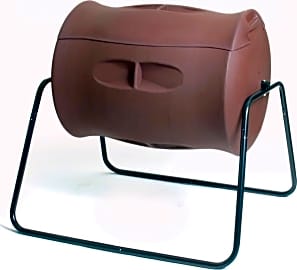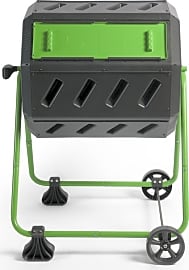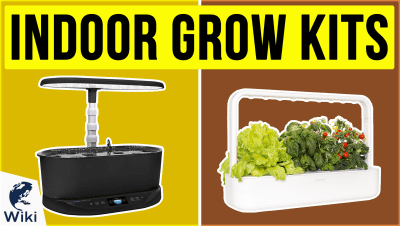The 10 Best Compost Tumblers

This wiki has been updated 38 times since it was first published in June of 2015. Whether you're trying to reduce your environmental footprint or you just want a better garden, composting is a great way to deal with your biodegradable waste. Simply take your food scraps, paper, and yard trimmings and dump them into one of these tumblers. Over time, nature will take its course, breaking it all down into a nutrient-rich mulch that your lawn and plants will love. When users buy our independently chosen editorial choices, we may earn commissions to help fund the Wiki.
Editor's Notes
July 29, 2020:
We have kept dual-sided compost tumblers in a range of sizes, including those with a stand and those without, ultimately removing the Kotulas 50-Gallon over concerns about its lid. Instead, we added the Riverstone Industries Maze. We like its large handle that features ratcheting action, something not many other choices can boast. It also has eye-catching green-on-black styling, although this isn't unique, as it's somewhat similar to the FCMP Outdoor HotFrog and the FCMP Outdoor HotFrog Mobile.
The Miracle-Gro Dual is a new addition, as well. It offers all the features you could want, including oxygen inlets, a stopper that locks the rotation, large doors, and more. It even comes with a pair of gardening gloves.
Finally, after some consideration, we have opted to keep the Envirocycle Bin. It seems to be a victim of design that's too clever by half, since the rolling bin and the built-in tea collecting base are actually harder to move and manipulate than one might think. Nevertheless, there's no stand that can break or rust, and it's billed as "the most beautiful composter in the world," which may or may not be true — but it's definitely more attractive than much of the competition.
April 15, 2019:
Even though we like its barrel-inspired styling, we decided to remove the Suncast TCB6800 because the strength of its frame doesn't live up to most high-quality choices. It's also not exactly easy to put together, although in all fairness, many larger compost tumblers can present something of an assembly challenge. Don't be surprised if you need a little assistance. If you don't want to be bothered with assembly at all, you might look at the Envirocycle Systems or the Good Ideas Wizard Junior, both of which arrive ready for action. As for top choices, we still like the Dual Body by Hot Frog, the Yimby IM4000, and the Jora Insulated. Each has a stand, which means no bending and stooping, and each is simple but functional, keeping unnecessary frustrations out of your day. We also decided to keep the Mantis Compact, despite occasional reported problems with rust. On the plus side, however, it has one of the most user-friendly turning systems and seems to respond well to rust-resistant coatings.
Special Honors
Oklin GG-10S For businesses that produce a moderate amount of waste, including restaurants and some small apartment complexes, the Oklin GG-10s is the way to go. A commercial compost machine, it requires only 24 hours to do its job, with a 90 percent maximum reduction rate at an input of up to 55 pounds per day. oklininternational.com
How Compost Tumblers Work
The process of composting begins by filling the compost tumbler up with kitchen scraps and waste matter from the yard.
Compost tumblers work through the same basic principles of composting as other methods, with one difference: they offer the ease of a self-contained, self-aerating unit. This makes the process available to anyone with the space enough to house the compost tumbler.
Using a compost tumbler involves a basic understanding of composting principles. In its most basic form, composting is the practice of turning food and yard waste into nutrient-rich soil amendments. It is most dependent on one single factor: creating the right conditions for the diverse bacteria which will turn this waste into compost.
The process of composting begins by filling the compost tumbler up with kitchen scraps and waste matter from the yard. It is also important to add a sort of starter soil to the bin, such as fresh compost or garden soil, as this contains the microbes needed to begin the process. As the compost tumbler fills, the decomposition process is already underway. Once the tumbler is full, it is time to focus on the task of aeration and turning.
Keeping an eye on the internal temperature of the pile, rotate the bin to add more oxygen and help the microbes reach as much surface area as possible. You will also want to open the hatch every few days to check for moisture levels. Compost should be damp, not wet. It should feel like a wrung-out sponge. Luckily, keeping these factors in mind is much simpler in a compost tumbler, as the unit offers a controlled environment not afforded by many other methods.
The Science Of Composting
Regardless of the composting method, there is an exacting science to composting that will need to be understood. In a composting tumbler, this is especially true, as the limited amount of space equates to less room for error. The first thing to understand is what is known as the carbon/nitrogen ratio, which is a very important factor in composting. If the compost mix is too low in nitrogen, it will not heat up. If the mix is too low in carbon and too high in nitrogen, it may heat up too much, killing off the beneficial composting microbes.
If the mix is too low in carbon and too high in nitrogen, it may heat up too much, killing off the beneficial composting microbes.
The best way to avoid these scenarios is to keep the carbon to nitrogen ratio at 30:1 when starting out. Then, as the carbon gets converted into carbon dioxide through the composting process, the ratio will naturally level off to around 10:1. This is the ratio that should be used for the rest of the process.
It is also important to understand particle size and composting speed. As a rule of thumb, smaller particles will break down much faster than larger ones. This is because the microorganisms eating at the pile can only get to the outside surface of the compost. The more surface area they can reach, the quicker the process of composting becomes. The importance lies in the ratio of surface area to volume. Typically, particles with more surface area for their volume are desirable, as they speed up the process of composting, and result in a more even product.
Because composting happens through the action of aerobic bacteria, the importance of oxygen flow within a composting method cannot be overlooked. In compost tumblers, this usually comes in the form of various small vent holes and through the action of turning the compost barrel. This also keeps the temperature within the desired range; quickly preparing the compost for its journey to the garden.
Bacteria In A Compost Tumbler
A good pile of compost, and therefore a good compost tumbler, is full of bacteria. They are what is at the heart of every compost pile, and without these bacteria; the soil would be arid and lifeless. Understanding the bacteria in a compost tumbler helps to create a better understanding of composting and the bacteria themselves.
Temperatures of 65 degrees Celsius and above will kill many forms of microbes which are responsible for decomposition.
In the first few days of the composting process, the tumbler is overrun with bacteria known as mesophiles, which help to break down the soluble, easily degradable nutrients within the tumbler. Some examples of mesophilic bacteria include Staphylococcus aureus, Salmonella, and Listeria monocytogenes. This is also the reason it is important to avoid foods such as meats, bones, and high-protein foods in compost tumblers; unfavorable mesophilic bacteria reproduce quite quickly on high-protein foods.
Mesophilic bacteria act to raise the temperature of the compost and set the stage for the thermophilic bacteria. These bacteria cause temperatures in the tumbler to rise even further; and many human or animal pathogens are destroyed in the process. These bacteria can take the heat in a compost tumbler too high, however. Temperatures of 65 degrees Celsius and above will kill many forms of microbes which are responsible for decomposition. This is why it is so important to watch the temperature of the compost tumbler closely.
After the bulk of their energy sources are spent, thermophilic bacteria begin to be replaced by beneficial mesophilic bacteria once again in a process known as curing. In a tumbler, this means leaving the vents open and leaving the tumbler alone; allowing the pile to mature itself and cool down its internal temperature.


